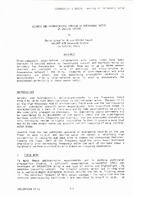| dc.contributor.author | Schmalfeldt, Bernd | |
| dc.contributor.author | Rauch, Dieter | |
| dc.date.accessioned | 2018-10-11T14:05:12Z | |
| dc.date.available | 2018-10-11T14:05:12Z | |
| dc.date.issued | 1982/06 | |
| dc.identifier | 611 | |
| dc.identifier.govdoc | CP-32/1 | |
| dc.identifier.uri | http://hdl.handle.net/20.500.12489/75 | |
| dc.description.abstract | Three-component ocean-bottom seismometers with radio links have been deployed in coastal waters to investigate natural and man-made noise at extremely low frequencies. Seismograms from one or up to three sensor stations are analyzed in terms of amplitude and cross-spectra at frequencies between 1 and 18 Hz. Examples of area dependence and wind dependence are given, and the underlying propagation mechanism is investigated. Finally ship-radiated noise is used to demonstrate the directional selectivity of those sensor units. | |
| dc.format | 12 p. : ill. ; digital, PDF file | |
| dc.language | English | |
| dc.publisher | NATO. SACLANTCEN | |
| dc.source | In: Underwater Ambient Noise (SACLANTCEN Conference Proceedings CP-32), Vol. 2, Part 1, 1982, pp. 5-1 - 5-12. | |
| dc.subject | Ambient noise | |
| dc.subject | Ambient noise - ship induced | |
| dc.subject | Seismo-acoustics | |
| dc.subject | Seismometers | |
| dc.subject | Acoustic propagation | |
| dc.subject | Radiated noise | |
| dc.subject | Low frequency acoustics | |
| dc.title | Seismic and hydroacoustic sensing of infrasonic noise in coastal waters | |
| dc.type | Papers and Articles | |
| dc.type | Conference Proceedings (CP) | |
